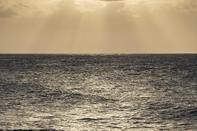
Temperature is influenced by various factors such as height above sea level, distance from the sea and latitude - the position on the North-South axis of the planet.
Altitude and Temperature
Altitude, the height above sea level, is a major factor determining air temperatures in South Africa, over-riding other influences on temperature such as latitude. For example, if one draws an east-west line along the same latitude from Durban to the top of the Drakensberg Mountains, the average air temperature decreases as one moves from the coast to the mountains. The average temperature difference due to elevation is about 11ºC.In addition, the lowest temperatures in South Africa is not influenced by latitude, but rather by altitude as the cool temperatures along the highest mountains in the country (Drakensberg, Maluti, Winterberg, Sneeuberg, Nuweveld, high mountains of the Eastern Cape and the Karoo) illustrate.
The Lowveld of Mpumalanga and Limpopo Province, and the Limpopo River Valley, are South Africa’s main vegetable production areas. These areas are especially important in winter when the temperatures of most other areas in South Africa are not suitable for vegetable production. The Lowveld and the northern part of Limpopo Province are also the country’s main production areas of subtropical fruits and nuts. These areas, especially the Lowveld, are at lower elevations than the other interior areas of South Africa and are known as very hot areas.
The most important factor is that the average daily temperature in winter (e.g. July) of the northern parts of Limpopo Province, and especially the Lowveld, is up to 6ºC higher than in the Northern Cape and Northwest Province areas - two other very warm areas of South Africa.
Most importantly, the minimum temperatures here in winter are up to 10ºC warmer than in the Northern Cape and Northwest Provinces.
Temperature and the Ocean
Water has a much higher heat capacity than rocks and minerals. This means water takes longer to heat and to cool down than the earth. Therefore, oceans have a big moderating effect on the air temperatures of coastal areas.In summer (e.g. in January) day temperatures along the coast are lower than those in the interior of the country, except areas at high elevations.
In winter (e.g. in July) day temperatures in coastal areas are higher than those in the interior of the country, except the Lowveld, northern parts of Limpopo Province, the Limpopo Valley and the middleveld areas north of Pretoria.
But the cool west coast areas, where lots of potatoes and other crops are grown under irrigation, have higher winter temperatures than the interior, except the areas mentioned above. The west coast is under the influence of the cold Benguela current, which flows northwards along the coast from the polar region in the far south.
Temperature, especially along the KwaZulu-Natal coast is influenced by the warm Mozambique current, a tributary of the Agulhas current, which flows southwards from the equator. Relatively high minimum temperatures along the east coast permit the selection of a wide range of crops.
Source Water Research Commission